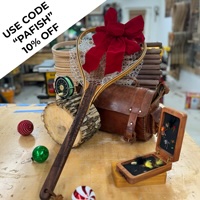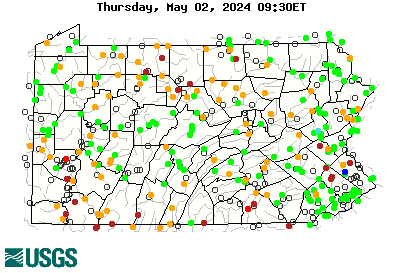The PFBC has a trout stocking for a local lake and I was wondering if anyone has any effective tactic and pattern ideas for fishing still water? I have no experience fishing still water for trout and I don’t know feeding behavior in this environment. The edges of the lake get heavy pressure with spinners, spoons, and live bait. Any suggestions?
You are using an out of date browser. It may not display this or other websites correctly.
You should upgrade or use an alternative browser.
You should upgrade or use an alternative browser.
Still Water Fishing for Trout
- Thread starter GoldenFly
- Start date
tomgamber
Well-known member
I have several. But its more fun just trying a seeing what will work.
buggers or streamers ...for distance (great practice right before a trip to the beach)
then fast stripping back near the surface...
or give them time to sink and bring them back slowly near the bottom.
or you can strip and then rest and strip and then rest, kind of like jigging.
I find fish tend to cruise in circling packs(schools) in stocked lakes. I will set up a caddis pupa or small nymph 2-4 feet below an indicator and let it sit in what appears to be their regular path. In this case its basically bobber fishing with flies and you can get caught sightseeing.
I prefer to use dies just like in the streams but I find that fish rise most exactly 10 feet further than I can cast.
My favorite way to fish still water is from a float tube. Its great exercise and you can kind of troll if nothing obvious presents itself. I have a kayak too but I still have a thing for my float tube.
buggers or streamers ...for distance (great practice right before a trip to the beach)
then fast stripping back near the surface...
or give them time to sink and bring them back slowly near the bottom.
or you can strip and then rest and strip and then rest, kind of like jigging.
I find fish tend to cruise in circling packs(schools) in stocked lakes. I will set up a caddis pupa or small nymph 2-4 feet below an indicator and let it sit in what appears to be their regular path. In this case its basically bobber fishing with flies and you can get caught sightseeing.
I prefer to use dies just like in the streams but I find that fish rise most exactly 10 feet further than I can cast.
My favorite way to fish still water is from a float tube. Its great exercise and you can kind of troll if nothing obvious presents itself. I have a kayak too but I still have a thing for my float tube.
Will you be in a boat or wading from shore? Could make a difference in what your limitations are. Trolling a furry nymph, streamer or wet on an intermediate line is a good option if you're in a boat. Once you find them, start making loops and pass over the same area.
oncorhynchusmykiss
Member
- Joined
- Jan 10, 2009
- Messages
- 101
I've found that in most stocked lakes and ponds they're not picky at all. If you can find em you can catch em. I fish some around pittsburgh and I've caught em on anything from a #24 midge to a bass popper and a size 2 spey. :-D If they're wild trout or fingerling stocked trout they tend to be more picky and I usually use drakes, midges, and damsel flies or streamers.
Good luck!!
Good luck!!
tomgamber
Well-known member
Damsels are deadly on lakes...
troutslammer
Active member
- Joined
- Aug 19, 2009
- Messages
- 1,258
slow strip a mayfly nymph this time of year
SkyBlue
Member
I have done well on a local stocked trout lake using a strike indicator and a two nymph set up. One size 14 FBPT and a Copper John. Flashing is good.
I let it sit and just give it a little pull every once and awhile working it back to me.
I fish where the water/creek flows in and keep it about 2 feet off the bottom.
Drys, not much going on this time of year and very hit or miss. I have had some luck on small caddis.
I let it sit and just give it a little pull every once and awhile working it back to me.
I fish where the water/creek flows in and keep it about 2 feet off the bottom.
Drys, not much going on this time of year and very hit or miss. I have had some luck on small caddis.
PSUFishMenace
Member
- Joined
- Aug 12, 2009
- Messages
- 733
My question is sorta related to the topic: say i need to get 30-40 ft of line out to get to the fish I want but don't have much room for a backcast. On a clear pond, would a roll cast in this situation spook fish? And is there a better way than this?
David
Active member
- Joined
- Jan 21, 2008
- Messages
- 1,837
Rookie wrote:
My question is sorta related to the topic: say i need to get 30-40 ft of line out to get to the fish I want but don't have much room for a backcast. On a clear pond, would a roll cast in this situation spook fish? And is there a better way than this?
A roll cast is likely your best bet. If you flick it sharply enough and pointing the rod slightly up at the end of the cast, you can get the line to straighten out over the water and drop softly...it'll take some practice at that distance, though.
If the bushes / trees aren't too high, or are back a little, you could also try a steeple cast...
http://gorp.away.com/gorp/activity/fishing/skills/steeple.htm
tomgamber
Well-known member
No, especially not in a lake. I mean, it could...but I have been forced to roll cast in gin clear mtn lakes for spooky fish with nothing but pines behind me. A lake where the difference between a size 14 and size 16 fly, and 5x and 7x tippet made a difference but roll casting didn't They may spook briefly but you will probably not put them down.
tomgamber
Well-known member
That steeple cast almost looks like a mini spey cast. I have used it without knowing it had a name.
osprey
Active member
- Joined
- Apr 1, 2009
- Messages
- 3,031
I enjoy the change of pace stillwater trout fishing here in Pa. provides us. When there is a nice hatch or just bugs on the water , that's where the fur ant and the damsels come in , eventually the larger trout get into the habit of cruising and sometimes while cruising they become what is known as gulpers , they cruise around at pretty much the same slow pace , conserving energy but feeding aggressivly as far as calorie intake is concerned. The timing is everything..........Watch out for those ospreys.
Goldenfly,
Based on the timing of your post, I'm wondering if this isn't one of the winter stockings designed to provide fish for ice anglers? If so, you'll be dealing (obviously) with cold water and dumb fresh stockies. I'd try a glo bug or greenweenie under a large indicator. Fish it almost like bait, slow retrieve. Rooted vegetation tends to die back a good bit by this time of year making fishing a sub surface nymph or wet fly much easier.
Based on the timing of your post, I'm wondering if this isn't one of the winter stockings designed to provide fish for ice anglers? If so, you'll be dealing (obviously) with cold water and dumb fresh stockies. I'd try a glo bug or greenweenie under a large indicator. Fish it almost like bait, slow retrieve. Rooted vegetation tends to die back a good bit by this time of year making fishing a sub surface nymph or wet fly much easier.
AlwaysWading
Member
- Joined
- Nov 4, 2008
- Messages
- 200
Take what you know about fishing in a deep long pool and follow what you do there. A really long deep slow pool is pretty close to a lake at the shore line. You can fish ant patterns like someone mentioned, or wolly buggers and a minnow like pattern. The skies the limit for your learning experiance,
adammathew
New member
- Joined
- Dec 28, 2009
- Messages
- 2
Hi Golden,
Fly fishing small still waters can be a great task for even the most experienced anglers. I'm going to share 3 top tips to fishing small still waters. Hopefully these few tips will help you increase your catch rate and have you catching fish even on the toughest of days. So lets begin!
Tip One:
Select the right equipment. (Always use the lightest gear possible when fishing)
Tip Two:
Move around.
One mistake I see an awful lot is when an angler fishes a spot too long and some times all day. Every 20 minuets you should move, even only a few feet.
First cover the water from left to right and start with short casts. After completing a movement of casting left to right start again with a longer cast. Also vary the depth your fishing the fly and the speed you are retrieving it. Then, move.
Start the same technique as above and when finished move again. The only time I would recommend not moving is when your catching fish constantly in the one area.
Tip Three:
Get some local knowledge!
Knowing the water you are fishing is important. Locals will tell you what flies work well or where the best spot to fish is.
If you don't get to talk to some local anglers then before you fish take a few minuets to just walk around the area your going to fish. Take note of over hanging vegetation, underwater features if you can see them and most of all signs of fish.
Cheers.
Fly fishing small still waters can be a great task for even the most experienced anglers. I'm going to share 3 top tips to fishing small still waters. Hopefully these few tips will help you increase your catch rate and have you catching fish even on the toughest of days. So lets begin!
Tip One:
Select the right equipment. (Always use the lightest gear possible when fishing)
Tip Two:
Move around.
One mistake I see an awful lot is when an angler fishes a spot too long and some times all day. Every 20 minuets you should move, even only a few feet.
First cover the water from left to right and start with short casts. After completing a movement of casting left to right start again with a longer cast. Also vary the depth your fishing the fly and the speed you are retrieving it. Then, move.
Start the same technique as above and when finished move again. The only time I would recommend not moving is when your catching fish constantly in the one area.
Tip Three:
Get some local knowledge!
Knowing the water you are fishing is important. Locals will tell you what flies work well or where the best spot to fish is.
If you don't get to talk to some local anglers then before you fish take a few minuets to just walk around the area your going to fish. Take note of over hanging vegetation, underwater features if you can see them and most of all signs of fish.
Cheers.
Because the water is still pretty warm, you still need to get fairly deep to reach the actively feeding fish, and since you will be using floating line, I would recommend using a bead headed nymph with a long tippet, or leader ( I like fluorocarbon ), maybe 6 or 8 feet, as this leader length will basically determine the depth at which you will be fishing. The beads on the fly will help to get it down to that regulated depth, and then you can adjust it accordingly. Try a Gold Ribbed Hares ear or maybe a Royal Coachman wet fly, whatever will sink fairly well. In a perfect world, you would know what is currently hatching in the area and would have a handfull of these flys ready for deployment, maybe you can research it and be as prepared as possible. I would leave the spinners to the spinning gear, as you will only cause yourself grief trying to throw a spinner with fly line.




Raff
Member
- Joined
- Jun 21, 2009
- Messages
- 77
Aaaahhhh.....Stillwater. How I miss it (used to fish Strawberry Res in Utah every weekend during the fall. The average Cutt & Bow there is 20" and 30+ fish days are pretty common).
For still water casting in clear water to spooky trout, the roll cast is the way to go. If you are in a pontoon, you can cast behind you, and use the water tension to hurl your fly forward to the fish.
In terms of flies, I like them all. I'm a fan of all of Kelly Galloup's stuff. Charlie Craven has some pretty good stuff - I once had a 40 fish day fishing a natural slumpbuster to Tiger Trout.
But my favorite stillwater fly is a tungsten beadhead olive-body bugger with orange schlappen for the hackle. Not too big though. This has been my single-most productive stillwater fly anywhere I fish. There's something about the olive/orange combo that drive stillwater trout crazy.
I would give a finger or two for a stillwater like Strawberry here in PA.
For still water casting in clear water to spooky trout, the roll cast is the way to go. If you are in a pontoon, you can cast behind you, and use the water tension to hurl your fly forward to the fish.
In terms of flies, I like them all. I'm a fan of all of Kelly Galloup's stuff. Charlie Craven has some pretty good stuff - I once had a 40 fish day fishing a natural slumpbuster to Tiger Trout.
But my favorite stillwater fly is a tungsten beadhead olive-body bugger with orange schlappen for the hackle. Not too big though. This has been my single-most productive stillwater fly anywhere I fish. There's something about the olive/orange combo that drive stillwater trout crazy.
I would give a finger or two for a stillwater like Strawberry here in PA.
wetnet
Active member
- Joined
- Mar 20, 2008
- Messages
- 1,412
So I take it that you don't enjoy stillwater? LOL! :-D
This may seem simplistic but that best that I can gather is if you reach the fish at a certain depth they have a circle pattern. You just need to figure out where it is and the time it will be when they are feeding.
So what do you have to fill in the gaps?
Very curious!
Very interesting topic.
This may seem simplistic but that best that I can gather is if you reach the fish at a certain depth they have a circle pattern. You just need to figure out where it is and the time it will be when they are feeding.
So what do you have to fill in the gaps?
Very curious!
Very interesting topic.





